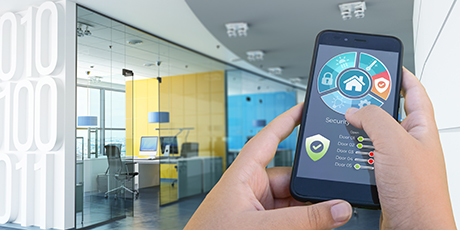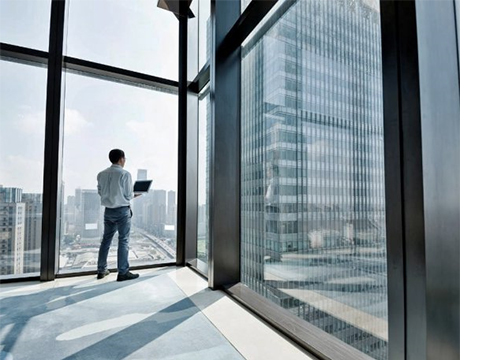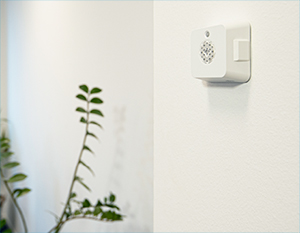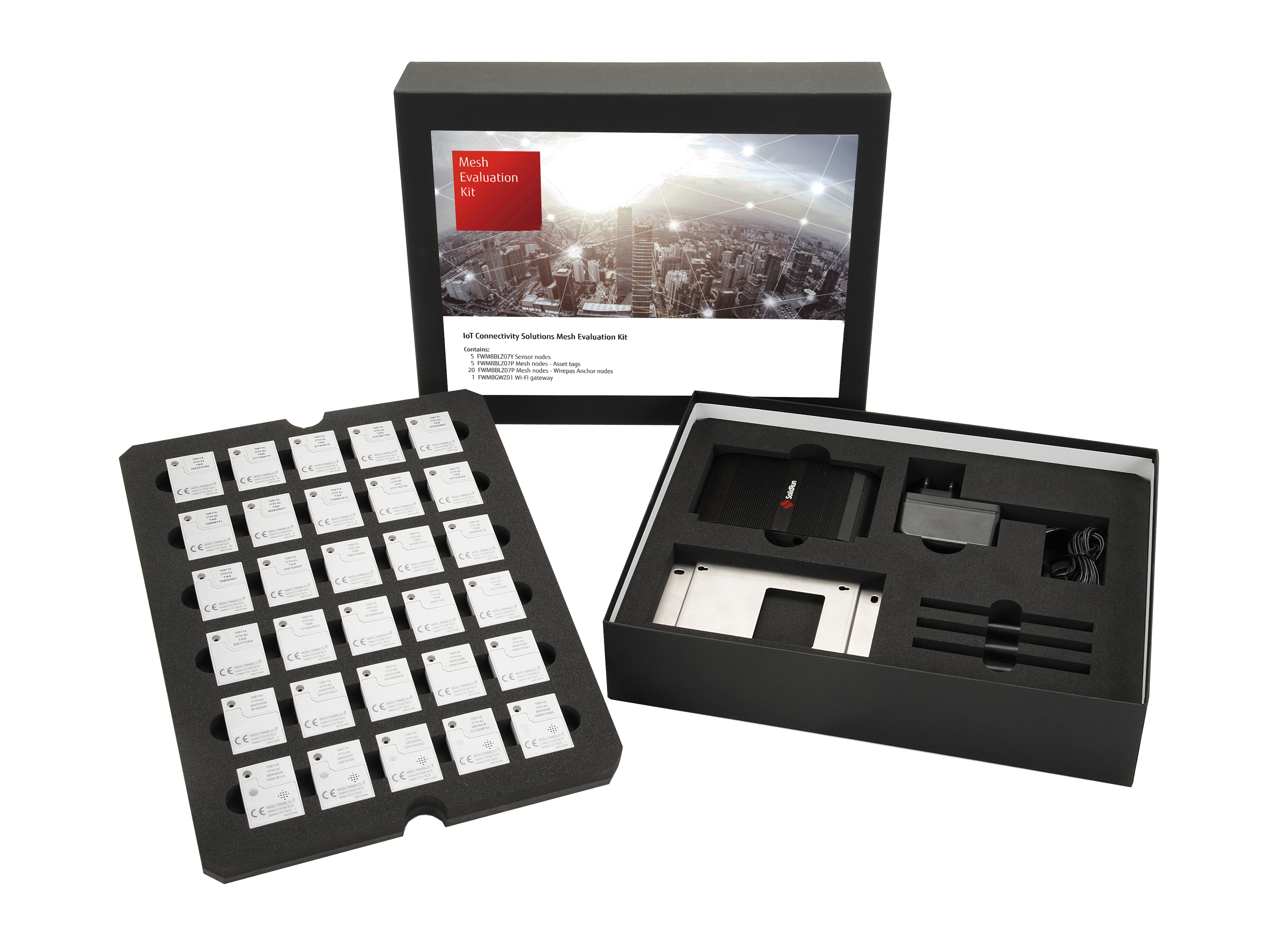IoT Solutions: Smart Buildings
Overview
FCL Components' IoT Solutions provide industry integrators and project managers with the tools they need to improve the energy efficiency and the comfort of smart buildings.
Environmental data is measured and wirelessly transferred to a central point. The data is made accessible through a dashboard where variables can be easily monitored. This ensures, insight in data, enabling improvement of business processes or environment variables such as temperature, humidity, CO2, etc. resulting in improvement in productivity, quality of life, or minimization of the carbon footprint.
Whether buildings are offices, commercial, industrial or institutional, FCL Components' mesh based IoT Solutions can make a difference.
FCL Components' IoT solutions; Asset Tracking, Environment Management and through our eco-system partners Smart Lighting and Indoor Navigation.
Asset Tracking
Asset tracking is the process of monitoring the whereabouts of business-critical physical assets within a location that is mobile in nature, such as mobile computing equipment or inventory containers.
Monitoring and controlling in-building or campus-wide assets used to be a very demanding. Tracking and tracing equipment and devices in large buildings can help to decrease time spent from core tasks.
- No unnecessary time spent searching for devices
- Easy maintenance
- Active and timely replenishment of devices
- Overall overview of devices available
How does it work?
A series of wireless, battery powered, anchor nodes installed in the building at known positions act as position reference points. Tags are mounted on the devices that require tracing functionality. The position of the tags is calculated based on the signal level received from the anchors (RSSI: Received Signal Strength Indication). The anchors also constitute the mesh network. Sending the tag position information from anchor to anchor, up to the gateway connected to the IT network or the cloud.The hardware installation is easy as it requires hardly any cable installation.
Anchors are able to transfer data through the network and acts as a router. By adding a Gateway the network is complete.
The benefits of the Mesh Network are:
- Scalability
- Self Healing
- No single point failure
- Hop by hop acknowledgement
- No interference
The dashboard, the data collected needs visualization, FCL Components has a fast eco-system in which various partners are available to visualize the data in a dashboard system.
Dashboard systems can be customized to accommodate exactly the data required.
Expanding
The FCL Components IoT solutions are easy to extend upon when the network has been formed through the anchors any other FCL Components or FCL Components eco-partner Solution can always be added. By example environment monitoring or indoor navigation.The network can also be set-up through eco partner smart lighting system, in that set-up the lighting fixtures form the mesh network.
Environment Monitoring
Smart buildings can help conserve costs on heating, air conditioning and power while also helping to reduce the impact on the environment.
Using FCL Components' environment sensors, building operators are given accurate measures of the ambient conditions, so they can monitor conditions and optimize heating, ventilation, and air conditioning (HVAC) controls, automatically, for maximum comfort. Such healthy environments increase output efficiency in occupiers while also ensuring they are more content, which only leads to better performance.
Additionally, FCL Components has developed a CO2 sensor which can sense all the parameters of the regular environment sensor plus CO2 levels. CO2 levels are also considered as indicator for viral particles, enabling monitoring of airborne infectious materials.
FCL Components environment monitoring solution enables monitoring of various environment variables:
- CO2
- Temperature
- Humidity
- Barometric pressure
- Illumination
- 3-axis acceleration
- Sound levels
How does it work?
FCL Components environment sensors do not require any cabling, when using batteries, and are easy to install by just fixing the sensors to the facility walls. CO2 sensors are powered by USB C cable due to its battery consumption.Through adding nodes, a Mesh network is formed, and enables data to be transferred through the network. The nodes act as routers, by adding a Gateway the network is complete.
It is easy to add sensors when the mesh network is already available through FCL Components' asset tracking solution or eco-system partner smart lighting. Just add the sensor and switch it on.
The benefits of the Mesh Network are:- Scalability
- Self Healing
- No single point failure
- Hop by hop acknowledgement
- Extremely low interference
The dashboard, the data collected needs visualization, FCL Components has a fast eco-system in which various partners are available to visualize the data in a dashboard system.
Dashboard systems can be customized to accommodate exactly the data required.
Expanding
The FCL Components IoT solutions are easy to extend upon when the network has been formed through the anchors any other FCL Components or FCL Components eco-partner Solution can always be added. By example environment monitoring or indoor navigation.The network can also be set-up through eco partner smart lighting system, in that set-up the lighting fixtures form the network.
Smart Lighting (eco-system partner)

FCL Components' eco-system network covers the best experts for the solution. Our Smart Lighting partners are all specialists in their own field, the products incorporate FCL Components modules which enables the lighting solutions to become part of the Massive Mesh network of FCL Components devices.
Smart Lighting enables lighting schemes for dedicated areas. Lighting settings can also function in combination with environment sensors to measure illumination levels and add less artificial light when sunlight is available.
When Smart Lighting fixtures of our eco-system partners are installed any eco-system device or solution can easily be added such as asset Tracking, Environment Monitoring or Indoor Navigation.
Indoor Navigation (eco-system partner)

FCL Components' eco-system network covers the best experts for the solution, our indoor navigation partner is the specialist with regards to indoor navigation.
With a mesh network in place through FCL Components anchors or a lighting solution, adding on indoor navigation does not require any additional hardware. You can navigate the building with your smart device.
Solution Brief
How FCL Components' Innovative IoT Solutions Enable a Whole New Generation of Smart Buildings
An increasing number of people are moving to live in cities. While about half of the world’s population currently resides in urban areas, the ranks of city dwellers will, according to the United Nations, increase to more than two-thirds (68%) of the world’s population by 2050—resulting in an additional 2.5 billion city dwellers across the globe. This migration has happened naturally over the past two centuries, with less than major consequences. However, it has in recent years begun to exert increasing pressure on public services, transportation, energy requirements, and the environment.
 One major solution that is helping to mitigate the negative effects of urbanization is the development of smart buildings. Under the smart buildings umbrella, building operations are connected through the integration of Internet of Things (IoT) devices. The connection helps to simplify tasks, like controlling building temperature, security, and maintenance through mobile devices and computers. The result is not limited to cost savings for businesses and the occupants based there. It also includes environmental benefits, among them a reduction in energy usage through real-time adjustments to heating, cooling, and lighting based on changes in weather and building occupancy. Essentially, because they can be monitored and adjusted remotely through IoT devices, smart buildings save money while reducing carbon footprints as well as minimizing energy consumption—an approach that helps to preserve quality of life. They also increase productivity and pave the way for business process improvement.
One major solution that is helping to mitigate the negative effects of urbanization is the development of smart buildings. Under the smart buildings umbrella, building operations are connected through the integration of Internet of Things (IoT) devices. The connection helps to simplify tasks, like controlling building temperature, security, and maintenance through mobile devices and computers. The result is not limited to cost savings for businesses and the occupants based there. It also includes environmental benefits, among them a reduction in energy usage through real-time adjustments to heating, cooling, and lighting based on changes in weather and building occupancy. Essentially, because they can be monitored and adjusted remotely through IoT devices, smart buildings save money while reducing carbon footprints as well as minimizing energy consumption—an approach that helps to preserve quality of life. They also increase productivity and pave the way for business process improvement.
This solution brief will explore FCL Components' menu of IoT solutions, available directly from the company and in cooperation with our eco-system partners and ranging from asset tracking and indoor navigation to environmental monitoring and smart lighting. We will examine how these interoperative innovations work together as part of the same network to give industry integrators and project managers the tools they need to help move forward the efficiency of smart buildings, with all tools accessible through a dashboard where variables can be easily monitored.
Asset Tracking
Asset tracking is the process of monitoring the whereabouts of business-critical, moveable physical assets within a given location—for example, mobile computing equipment or inventory containers.Monitoring and controlling in-building or campus-wide assets was once a very demanding and laborious task consisting of endless manual processes. It was also characterized by multiple asset visibility gaps. However, thanks to modern asset management platforms, businesses can now automate many asset tracking processes while gaining real-time visibility into the location of expensive and mission-critical mobile components.
![]()
The FCL Components Mesh IoT solution can enable asset tracking through live monitoring of thousands of assets in smart buildings across a whole host of industries, from healthcare and manufacturing to hospitality and corporate spaces.
FCL Components' mesh-based asset tracking solution works by employing Bluetooth LE tags, nodes, and a gateway to provide live, real-time tracking; analytics; and location-based services for equipment.
The two most important tools for asset tracking are:
TheFCL Components Mesh Anchor node
This is a water-resistant (IP65), battery- or USB-powered device that simultaneously works as a reference point for mesh-based asset tracking, a router node for the infrastructure, and a beacon for indoor navigation. Flexibility when it comes to installation ensures top performance.The FCL Components Mesh Asset tag
A highly appropriate tag for medium-to-large-sized assets, the mesh asset tag is water resistant (IP65-rated) and battery- or USB-powered. It boasts a multicolored LED light that can reduce picking errors, along with a 3-axis accelerometer sensor. The latter can trigger assets to share their location on movement, or go into deep sleep mode when standing still to further extend its already long battery life.
The system delivers immediate access to automatically updated asset location information, enabling inventory management and the prevention of loss or theft.
Delving deeper into its operation, the system tracks tagged assets by broadcasting their location to mesh-networked nodes. Multiple nodes placed throughout the facility receive the data from the tags and transmit it, along with the appropriate node ID, to a central gateway. The gateway sends the location of the assets to a cloud-based server, allowing business owners to remotely monitor asset movement and access analytics and reports from an Internet-based dashboards. It also enables end-users to maintain an overview of when and where particular equipment, tools, or machines have been used. Tracking assets in this manner is a process that would otherwise prove costly from a financial and time standpoint.
Moreover, the solution is highly scalable. In fact, various use cases demonstrate the flexibility of Wirepas Mesh to accommodate copious numbers of sensors and remain functional, even in the toughest environments and situations.

Environmental Monitoring and Management
As noted in the introduction to this solution brief, the ability of smart buildings to help conserve costs on heating, air conditioning, and power while also helping to reduce environmental impact is spurring their popularity. But how is this made possible?Environmental monitoring is one catalyst here. Wireless indoor environment sensors yield accurate measures of ambient conditions. These conditions can be monitored, with heating, ventilation, and air conditioning (HVAC) controls then automatically optimized for maximum comfort. Such healthy environments increase the productiveness of building occupants and render them more content, which only leads to better performance. In fact—and not surprisingly—many new commercial construction projects involve smart buildings because the benefits afforded by environment monitoring are so attractive. And demand for environmental monitoring systems is on a sharp uptick, reaching $19.89 billion in 2020 and projected to reach $43.48 billion by 2030, according to Allied Market Research.
However, the main challenge these days is making the work environment as convenient as possible for employees, customers, and visitors, while also improving efficiency and reducing costs. FCL Components' Endurance line and the mesh technology that connects its components contribute to the attainment of these goals, with two tools in particular facilitating with environmental monitoring and management. They are:
FCL ComponentsMesh Sensor Unit
As a fully packed unit with sensors, this mesh device works to monitor environmental conditions. Battery- or USB-powered, water-resistant (with an IP65 rating), and easy to install, it features the following sensors:- - Temperature – Humidity
- - Barometric pressure
- - Luminance
- - 3-axis accelerometer
- - Sound level
Additionally, the device touts a multicolored LED that can be used to identify certain conditions by blinking in different colors and rhythms. It can also act as a beacon for indoor navigation.The FCL Components Mesh Sensor Unit with CO2
This water-resistant, USB-powered unit has been specifically developed for the demands in such crowded environments as classrooms, meeting areas, office departments, and public buildings. With a constant and reliable power supply and a built-in CO2 sensor that sits atop all sensors in the sensor unit, it is able to monitor areas where the air quality is contributing to the health, physical concentration, and comfort of its users. By detecting CO2 levels, this sensor is able to identify if the building is properly ventilated, which is especially important in a world post-COVID.
The well-being of children at school, workers on the production floor or in the office, and recovering patients in hospitals is more important now than ever before. The mesh sensor units described here are capable of monitoring all the influences that impact health, from CO2 levels and ventilation to temperature, humidity, and barometric pressure, in turn allowing for climate adjustments and ensuring occupants’ comfort. Just as significantly, the luminance sensor provides information on the light intensity in rooms, allowing for more efficient use of luminaires and yielding energy savings.
The unique combination of the above-described sensors, along with noise monitoring, can help to create a pleasant environment for all smart building users.
Indoor Navigation

When navigating an unfamiliar place in the outside world, GPS is the usual “go-to.” However, this technology does not work as well indoors; a different type of technology is needed to find, for example, various rooms of an office block. Indoor navigation systems fit the bill, leading to explosive growth in the indoor navigation systems market. According to Market Research Future (MRFR), the global indoor positioning and navigation systems sector will exhibit a CAGR of 30.5% between 2018 and 2023 and will be worth $24 billion at the end of the forecast period.
Indoor navigation works by offering mobile device users a floor map that is accessed within a dedicated app or web app. Within this portal, they can search for locations within a building or indoor location and receive directions to a specific location, even one that is on a different floor. Direction is provided in the same manner as with a GPS does, via a step-by-step “blue dot” navigation that is updated in real-time as individual users navigating the space.
FCL Components provides indoor navigation in alliance with eco-system partners through beaconing via our FCL Components Mesh Anchor node, which is just one part of our Endurance Line of IoT Smart Building devices.
The technology works by transmitting a continuous radio signal via Bluetooth Smart. The signal provides an ID number that the phone then uses to identify an individual’s location inside the building. Because the process occurs in real-time and does not entail the mere display of a static map, individuals can be easily guided through indoor spaces in the same manner they would when utilizing GPS outdoors.
The indoor navigation technology is not just for office spaces. It can be used across all types of intricate buildings, such as airports, shopping centers, museums, hospitals, and even big event spaces like stadiums.
The main benefits of using this technology within smart buildings are related to visitor experience and satisfaction. It can prove more than beneficial for new employees or even for established employees if the space is particularly large or has a complex layout. Indoor navigation means those inside the building can more easily find what they are looking for without wasting time running between floors or getting lost in departments with which they are unfamiliar, improving employee performance and efficiency.
Indoor navigation can also help lower costs, especially staffing costs, for businesses that take advantage of the technology. What’s more, companies can use the data they gathers from system users to make smarter decisions about the space and layout to improve efficiency and business operations in the future.
Smart Lighting
Replacing traditional fluorescent, halogen, and incandescent lamps with LEDs has already brought massive benefits in energy savings and lifetime cost, whether for indoor or outdoor applications. However, when lighting modules are organized as “things” on the Internet, further advantages follow. 
Connected smart lighting can add intelligence, feedback, and control to traditional installations. Setting the right lighting scheme for the environment and adjusting it to the time of day can help to improve the work environment for employees or provide that improved visitor experience. Leveraging the proper lighting scheme can also help to reduce energy consumption, especially in combination with lumination data obtained through the environmental sensors.
However, the benefits of smart lighting in smart buildings can only really be achieved through scale. This presents its own challenges, namely, cost, cost-of-ownership, and reliability. IoT devices need to connect reliably in frequently changing radio environments. Energy consumption is also a major concern, as is latency, especially for environments where responsive lighting is needed.
FCL Components Solutions
FCL Components’ IoT connectivity solutions can help here. The Wirepas de-centralized wireless communication protocol on FCL Components’ wireless modules allows IoT lighting devices to make all decisions locally and co-operatively. This enables more reliable, scalable, and easier-to-use connectivity for lighting devices. Adding over-the-air (OTA) update capability to this technology also extends the lifetime of the hardware, additionally improving security and lowering the total cost of ownership.By implementing smart lighting systems together with its eco-system partners, FCL Components provides energy savings while increasing the quality of light within smart buildings. Such savings and improvements are made possible by FCL Components Mesh modules and regular Bluetooth modules, which allow remote control of the luminaries and, in turn, enable:
- Grouping
- Daylight compensation
- Color and intensity control
- Setting lighting sceneries pending the use of space
- Light settings based upon occupancy
The true benefit of adding the FCL Components Mesh Module transcends turning lighting “smart.” It instantly becomes part of the FCL Components ecosystem, to which asset tracking and environmental monitoring can easily be added.
Wirepas Mesh Technology and How it Works
Wirepas Mesh is a technology specifically developed to support massive mesh networks. With Wirepas Mesh, up to 1,500 nodes in one cubic meter can be part of one single network that is both vast and granular at the same time while always maintaining its robustness.Nodes can be miles apart or packed tightly together. They are always in touch with their neighbors, determining the optimal route (in terms of integrity, energy efficiency, and speed) for every “package” they encounter. In the case of a smart lighting system, these packages can contain lighting data, but this is not a prerequisite. In fact, having the smart lighting network in place allows for other smart information flows, such as environmental data or asset tracking. With Wirepas Mesh technology, everything can work collectively.
Curious if this is the right solution for you?


